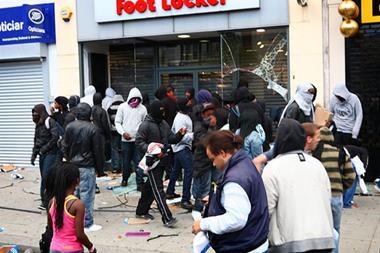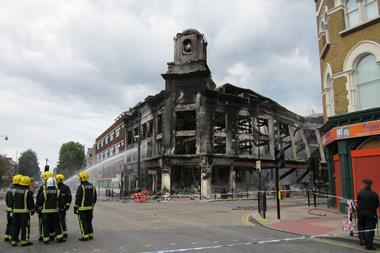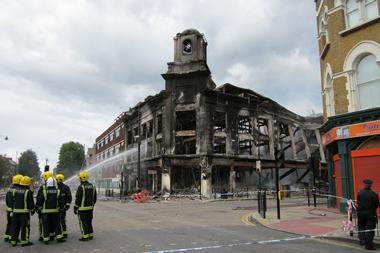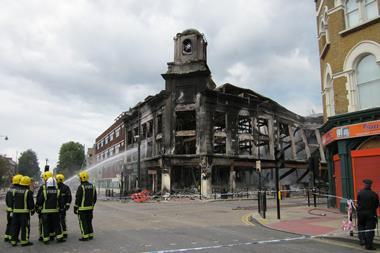As the ABI estimates that the bill for the UK riots will end up close to £200m, experts predict calls to reform the law
The riots that engulfed urban areas across England last month were the biggest disturbances of their kind since the 1980s.
Loss adjuster GAB Robins classified the riot as a surge event on Monday 8 August, when the police appeared to lose control of large parts of the capital and disturbances were spreading like wildfire to other English cities.
Cunningham Lindsey’s analysis of its major losses shows that the bulk (84%) occured in London, with the rest divided between Birmingham and Manchester.
Around 60% of major losses were suffered by large national chain stores. Unsurprisingly, clothing and footwear retailers are heavily represented among the worst-hit companies.
But as the smoke has cleared, quite literally in many places, a less alarming picture has emerged. While figures of up to £750m were being quoted in the immediate aftermath of the disturbances, most industry observers agree with the ABI’s estimate that the bill will end up around the £200m mark, which equals around 4% of the UK’s average property losses per annum.
Handling the upsurge
Some insurers have been worse hit than others, notably RSA, which covered the Enfield Sony warehouse that went up in flames during the riots.
AXA commercial claims and underwriting director David Williams puts the monetary impact into context by noting that the insurer has lost more from the destruction of individual buildings than as a result of early August’s disorder. Brit’s losses are understood to have been less than £1m.
Cunningham’s director of adjusting, Alan McNeilage, agrees: “It’s a major event rather than a surge.”
He says Cunningham has been able to deal with the upsurge in claims without having to hire any extra staff, as many firms had to do following last winter’s burst pipes surge.
And the riots no longer look like the rates game changer that they did when images of burning buildings were monopolising the news bulletins. Williams says: “I would love to push rates up because rates need to increase, but I am not sure that this is a big enough event.”
The fine print
However, the pill has been sweetened for insurers by the Riot (Damages) Act, the 1886 legislation that says police authorities must pay compensation for any destruction resulting from a breakdown of public order.
Following negotiations with the Home Office, led by Aviva claims director Dominic Clayden, the ABI established that property losses will be covered by the act, but that business interruption and damage to motor vehicles resulting from riots will not.
Firms in riot-struck areas that did not suffer physical damage will have been examining the fine print of their business interruption policies to see if they contain extensions providing cover for denial of access and loss of attraction.
Brokers have experienced a surge of interest in such extensions over the last fortnight, according to Biba head of corporate affairs Graeme Trudgill.
Appetites will have been whetted by the widespread nature of the riots, which didn’t just hit gritty inner-city areas, but leafy suburban centres like Ealing and Enfield, too.
As the ABI points out, the scheme’s existence ensures areas that have been affected by rioting are not penalised.
A spokesman for the Association of Police Authorities (APA) says that it was “delighted” with prime minister David Cameron’s commitment to pay compensation for all riot-related claims.
However, this safety net is not guaranteed. While the government has come to the industry’s aid this time, it may not be as happy to fork out if and when there is a repeat of August’s events.
The APA is pushing for the scrapping of the existing scheme on the grounds that public-funded authorities shouldn’t have to pay for the cost of disorder and rioting.
City law firm RPC partner Stuart White says: “Given the scale of these riots and the current pressure on police budgeting, there will doubtless be calls to reform a law that compels police forces to compensate businesses and individuals for riot damage.”
Further rioting is not expected this year. But the public spending cuts that are just starting to bite along with high levels of youth unemployment provide ripe conditions for disorder. In the future, the public purse may not be so ready to accommodate the industry.





































